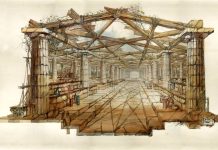Let’s listen to Barnett’s opinion: “The collapse of power during periods of social and political upheaval opens the way for innovation. The social instability that occurs during conquests, civil confrontations, economic booms and crises creates favorable circumstances for the emergence of new ideas, which often have a predatory character.” Even if we do not take into account the various wars that Europe has experienced, societies in the countries of the continent have experienced many shocks since the nineteenth century.
Intensive population growth, rapid urbanization and industrialization (usually large-scale), as well as a huge increase in mobility are all factors that have more or less constantly contributed to innovation. Thus, the designers had considerable scope to introduce innovations and come up with proposals for something new that had not been there before, something that would fit into Barnett’s broad definition, which also included the traditionalist architecture of such, for example, masters as Paul Schmithenner or Heinrich Tessenov.
Change is the very essence of any socio-cultural system, but its speed varies in different places. In Europe — since the nineteenth century — the changes have been rapid. And in the conditions of this permanent dynamism, such accelerating factors as the revolution of 1917 in Russia or two world wars took place, which led to the need for grandiose restructuring. If we turn to the local level, we can recall, for example, the 1963 earthquake in Skopje, which made the emergence of a plan for the reconstruction of the city inevitable and required the participation of such foreign architects as Kenzo Tange and Alfred Roth.
Recognizing that shocks themselves create room for innovation, we relatively rarely see the relationship between innovation acceptance and well-being. Since the nineteenth century, almost the whole of Europe has experienced a marked increase in prosperity; the countries of the post-war Eastern bloc were no exception, where economic growth rates remained comparable to those observed in the “free West”, at least until the 1960s.
If we talk about innovations, it is worth mentioning that the age of architects also plays a role here. Contrary to Le Corbusier’s assertion that real work begins only after the fiftieth birthday, in the biographies of many architects, the peak of success falls on the age of thirty-two to fifty-eight years. And this has always been the case since 1700. Of course, there are exceptions to this rule: some architects achieve great achievements in their youth, while others continue to achieve a lot in old age. But in general, it can be noted that for the most part architects create their first significant projects shortly after thirty, and the last ones are completed before their sixtieth anniversary.
In many cases, their work in their younger years has the most experimental and innovative character. It often happens that it is the early works that distinguish (or are intended to distinguish) one or another architect from previous generations. Youth is always an important factor in the craving for innovation: an architect wants not to be like his predecessors, he consciously looks for new approaches and solutions, kindles an optimistic belief in his ability to create something better than what was created ten or twenty years ago, and does not think what can happen when his best solution it will become ten or twenty years older.



















